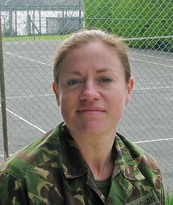Chapter 14 E-materials
Author profiles
Captain Mark Jenkins MSc BSc(Hons) MCSP RAMC
Defence Medical Rehabilitation Centre, Headley Court, Epsom, Surrey.
He is currently Officer in Charge of the Army’s Primary Care Rehabilitation Facility in London.
Case Study 14.1 Neurorehabilitation
Background
• 55-year-old female with a presentation of neurofibromatosis.
• Worked as a film editor full time, drove to work. Lives with her husband and family in a town house with stairs.
• She enjoys cycling and walking.
• Prior to onset two years ago she had suffered no major symptoms from the condition.
• Two years ago she underwent a cervical laminectomy C5/6 to relieve S&S of spinal cord compression.
• Six months after this she underwent further surgery in the lumbar spine at levels L1/2 and L3/4.
• She was referred for rehabilitation following surgery as an inpatient (2 weeks), then transferred to outpatient community services (8 weeks).
Treatment aims
• Improve and maintain existing muscle length and strength in the arms and legs whilst working on improving balance reactions and function.
• Prior to working on the cervical and lumbar spine range of movement the physiotherapist checked with the neurosurgeon regarding any limitations or restrictions. None were identified, so treatment also targeted gentle progression of range of movement in the neck and back.
Upper limbs and balance
• Throwing and catching balls initially in sitting with the ball thrown from a short distance to standing and throwing from further away. Gradually increasing the difficulty of the task, once previous task was mastered. Combined work on muscle strength and co-ordination with automatic balance worked well. The size and shape of the ball was used to increase or decrease the difficulty. Progressed to standing.
• Fine hand work targeted function. Peg boards, handwriting, paper folding, griping objects provided stimulus for the hand function. Some compensatory strategies were involved to allow for success, e.g. adaptation of the pen, knife and fork grips. Improvements occurred as a result of practice and the adaptations were reassessed.
• Postural advice and education was provided at every treatment session together with some general advice on shoulder girdle movements including elevation and depression and elevation through flexion and abduction.
Lower limb work and general reconditioning
• All muscle groups were active, but weak.
• Strengthening using sit to stand, increasing the repetitions and changing the speed from fast to slow and slow to fast. Using hands and arms to assist initially, progressing to no assistance.
• Getting on and off the floor to reduce the anxiety and fear of falling.
• Walking practice to increase distance, speed and exercise tolerance.
• Timed 10-metre walking, initially with 2 sticks progressing to 1 stick.
• Stretches taught for all muscle groups.
• Home exercise programme taught and checked, with progression daily/weekly.
Case Study 14.2 Complex trauma
Background
• 22-year-old, right-handed sniper who has served  years in the Army.
years in the Army.
• Lives alone in base accommodation.
• The following injuries were caused by an improvised explosive device (IED) whilst on duty in a combat situation 1 year ago:
• He underwent multiple operations for debridement of wounds.
• His right wrist was fused and the ulna head was excised.
• EDC was repaired in the right hand and the wound was covered and reconstructed with a left serratus anterior free flap.
• He had full memory of the incident, but was experiencing little in the way of flashbacks or nightmares.
Rehabilitation
• Following the acute hospital management he was transferred to rehabilitation.
• He was experiencing low mood and anger issues at this point as his right wrist wound had deteriorated and metalwork had begun to protrude.
• An X-ray suggested osteomyelitis in the distal radius and consequently the metalwork was removed and bone grafts inserted, prior to him beginning his rehabilitation programme.
Identified problems
• Soreness of the stump, pressure pain from the socket fit.
• Gait disturbance – slight Trendelenburg in walking.
• Poor gait on steep slopes and stairs.
• Decreased hip strength – glut med 4/5, glut max 4/5.
• Decreased quads strength 3/5.
• Poor balance and proprioception.
• Poor grip and writing – 9 Hole Peg Test on admission; right – 50.3 seconds left – 21.6.
• E-Link Grip Strengths; on admission – 75.5%.
• Problems finding his COG in swimming.
• Mood, sleep and anger issues.
Stay updated, free articles. Join our Telegram channel

Full access? Get Clinical Tree











